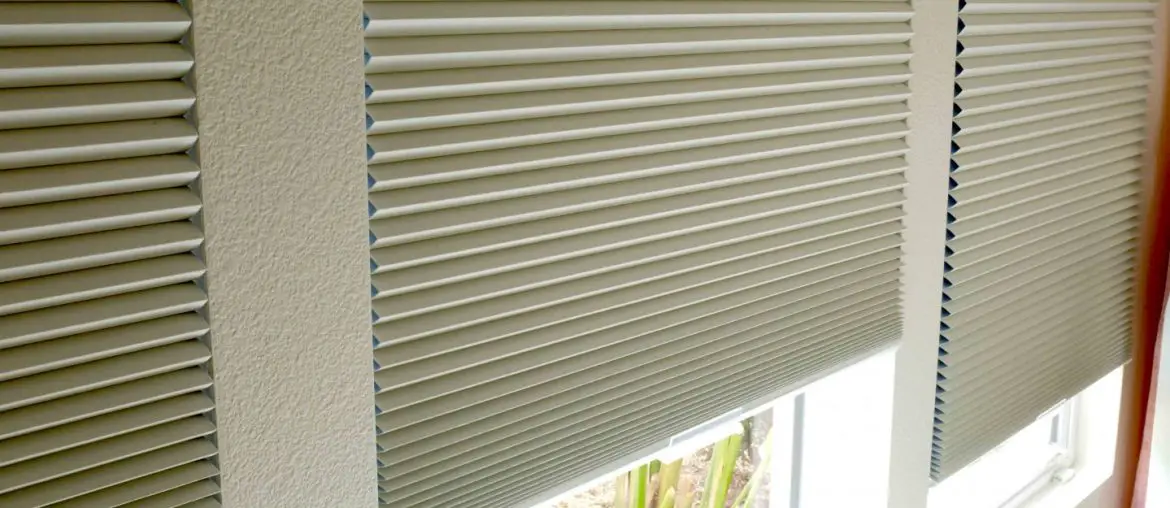Table of Contents
Single Cell Vs Double Cell Shades
Choosing single cell vs double cell shades is a tough decision when it comes to window solutions. Finding the most versatile and energy-efficient solution out of them for home décor is very important. The cellular shades are most popular for their unique structure and crisp pleats. They come in many color options and fit every window depending on their functional values. You can use this aesthetic appeal to improve the quality of your living space. They have hexagonal honeycomb structured air pockets that create a phenomenal makeover. If you have doubts about choosing the best type of cellular blinds, then you can find all you need to know from here.
What are Cellular Shades?
Cellular shades are window coverings made of fabric material to be used as blinds in front of windows. The pleats fold up to make cells in between them. This mechanism is different from the roller shades that roll around a tube. The cellular shades come in two options as single-layered cells and double-layered cells. This type of window covering offers the advantages of being versatile and providing privacy while controlling both heat and light.
Difference Between Single Cell And Double Cell Shades
The shades consist of two layers of pleated fabric and have air pockets in between them known as the cells. These cells create a barrier to excess air that comes through the window by holding hot and cold air inside. The single cells have one layer of pockets, while double cells have two layers. Having more cells in the shades increases the insulation. The power of insulation is measured by the thermal resistance given by the R-value. Compared to other window dressings, the value of cellular shades is from 3.5 to 5.
Single Cellular Shades
Single cellular shades have one layer of cells and use less fabric and manufacturing time. Therefore, they are less costly and are available in various shades such as lightening, darkening, and blackout materials. The pleat prices vary from 3/8 inch to 2 inches. It is ideal for small windows and creates a clean and neat look for the windows. Since they have fewer cells, it is easy to clean double cell shades.
Double Cell Shades
Double cell shades have two layers of air pockets and create high energy efficiency. They reduce more heat transfer through the window and have high insulating properties. They come in a wide range of colors, fabrics, and lift options. Hence, this is a very favorable choice among most homeowners. The design of these shades uniquely fits all the shapes and sizes of windows and flawlessly matches all décor styles. The style options can help you transform your living space into a comfortable environment. Even though double cellular shades are quite expensive than single cell shades, the insulating ability makes it worth the cost. But the drawback is that these are only available in small cell sizes.
Small Cell Sizes
Small cells are made of narrower pleats and are ideal for smaller windows. The smallest cell size available is 3/8 inches. However, using these small cells in big windows would not be a good choice as it would appear chaotic and give a busy appearance due to the excessive number of cells and horizontal lines. This would look best on narrow window sills where they would fit naturally.
Medium Cell Sizes
Medium-sized cells would ideally reflect the size of medium-sized windows. They have cell sizes of ½ inches or 9/16 inches. These medium-sized cell shades are popular due to the good balance they provide for all window sizes.
Large Cell Sizes
Large cells are of ¾ inches and are suitable for covering larger windows. It is necessary for these shades to be light enough, and not require any other support as they cover a large area of windows. This is why large cells are used for larger windows. Due to the large pleat size, more aesthetic appeal is brought into the building. If there are larger window sills, then that space can be made use of, as these large cells can fit in them perfectly. So depending on the size of your window sizes, you can choose from 3/8 vs ¾ cellular blinds for the application.
What is the Best Choice?
The single-cell and double cellular shades are elegant in their own way and provide high energy efficiency, worth the investment. However, your choice would depend on your budget and other concerns. If you are concerned about the cost and appearance, then you can go for a single cell shade. If you are looking for noise reduction and proper insulation, then double cell shades are your ideal choice. Let’s find out more about why these choices are the best.
Single Cell is Right:
If you want a clean look
Single-cell shades have slightly bigger cells than double cells. Bigger shades mean lesser rows, which create a less busy look on the shade. So fewer rows would mean a lesser number of horizontal lines, and therefore brings a more arranged look. If you need a clean and tidy look on your windows, then single-cell shades are the best choice for you.
If you want the most affordable cellular blind
Single cells are less costly than double cells as they require less fabric for the manufacturing process. Also, single cells are easy to be made and consume less time comparatively. This provides you with a significant saving on the expense while giving benefits of reduced cost on your heating and cooling.
Double Cell is Right:
If you want the most energy-efficient type
Double cells perform the task of reducing heat transfer even better than single cells. The additional layer of cells creates better insulation in both cases of preventing cold air from coming in and going out through the windows. So double cell shades are the choice of most energy-efficient window coverings than single cells. Having Low-E window films installed in your home would increase the benefits of saving energy costs.
If you want better heat insulation
Double cell shades are ideal for freezing climates due to their ideal heat insulation. Areas with the temperature falling below freezing point need special insulation to keep the interiors comfortable. The double layer of cells helps in this process than single-layered cells and helps you stay warm even in the harsh cold winter seasons.
If you want the best in noise reduction
Cellular shades offer the best noise reduction solution of window coverings. Out of the two, double cell shades provide a better solution. Just as double cells offer better heat insulation, it provides better noise damping abilities too. So if you live in a noisy area close to a busy street, then double cell shades would give you the best noise reduction in window coverings. This would bring similar effects of window soundproofing films installed over the windows.
What is the Difference Between Honeycomb and Cellular Shades?
This is very confusing for most of the buyers as some shades are named honeycomb while the others as cellular. However, both these names refer to the same thing. This confusion occurs because different manufacturers use both these names to define their various products depending on the shape created by the cells. So regardless of the name, you will be purchasing the same type of window covering.
Do Double Cells Block More Light than Single Cells?
Despite having an additional layer in double cellular shades, they do not block more light than the single cells. They have similar effectiveness in this, unlike in noise reduction and energy efficiency. However, the amount of light penetration would vary depending on the type of material used in these shades.
The cellular shades have the top-down or bottom-up feature, which is beneficial for large, long windows and sliding glass doors. This is also ideal for bathrooms on lower floors where additional privacy is required. These blinds can be adjusted in both directions, allowing light to come from both directions while securing privacy. If you are further concerned about the privacy of your place, you can use frosted window films over your windows.
Do Cellular Blinds Block UV Radiation?
Both single and double cellular shades successfully block UV rays. The fabrics used in both these blinds effectively absorb the harmful ultraviolet radiation without allowing it to penetrate the interior. This safeguards your furniture, fabrics, and paintings from fading and reduces negative health impacts. It also reduces glare inside while blocking 99% of UV radiation. This is as efficient as the application of UV blocking window films.
Conclusion
So as described, there are several benefits and customization options for the cellular blinds that are offered by single cell vs double cell shades. This starts from the construction structure itself and extends up to the reduction of utility costs. So depending on your requirements, you can choose one of them to optimize the comfort of your place.
If you are interested in getting your windows tinted to increase the benefits of cellular shades, you can try home window tinting. If you own a business place or an office, you can find commercial window tinting applications especially for this.








